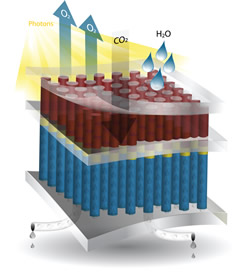September 1, 2013 – “We’ve developed a method by which molecular hydrogen-producing catalysts can be interfaced with a semiconductor that absorbs visible light.” So says Gary Moore, of the Berkeley Lab Physical Biosciences Division. The results, a bionic leaf that produces hydrogen and the byproduct, oxygen.
The pursuit of artificial photosynthesis has been one I have written about in past blogs. If we can develop a low-cost equivalent to what leaves do it would yield all kinds of advantages for humanity and the planet, helping us solve two of our most pressing challenges: our need to develop sustainable green energy and the requirement to reduce atmospheric global warming from CO2 and other greenhouse gas sources.
Berkeley and Caltech have created the Joint Center for Artificial Photosynthesis (JCAP), dedicated to develop artificial photosynthesis that is ten times more efficient than what plants do. They are doing this using photocathodes that generate hydrogen from illumination. The photocathodes are made from gallium phosphide coated with a thin film polymer called vinylpyridine. The latter is chemically treated with cobaloxime catalyst which significantly boosts hydrogen output. Gallium phosphide is limited in reacting to the full spectrum of light so the researchers are testing other materials to see if they can further increase yields. The end result will be a solar-fuel generator that also provides net CO2 emission reductions.









